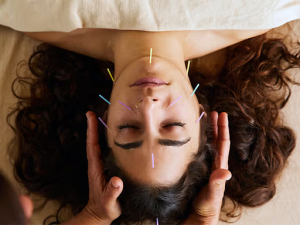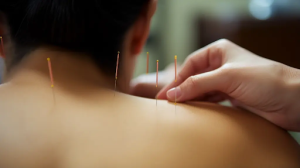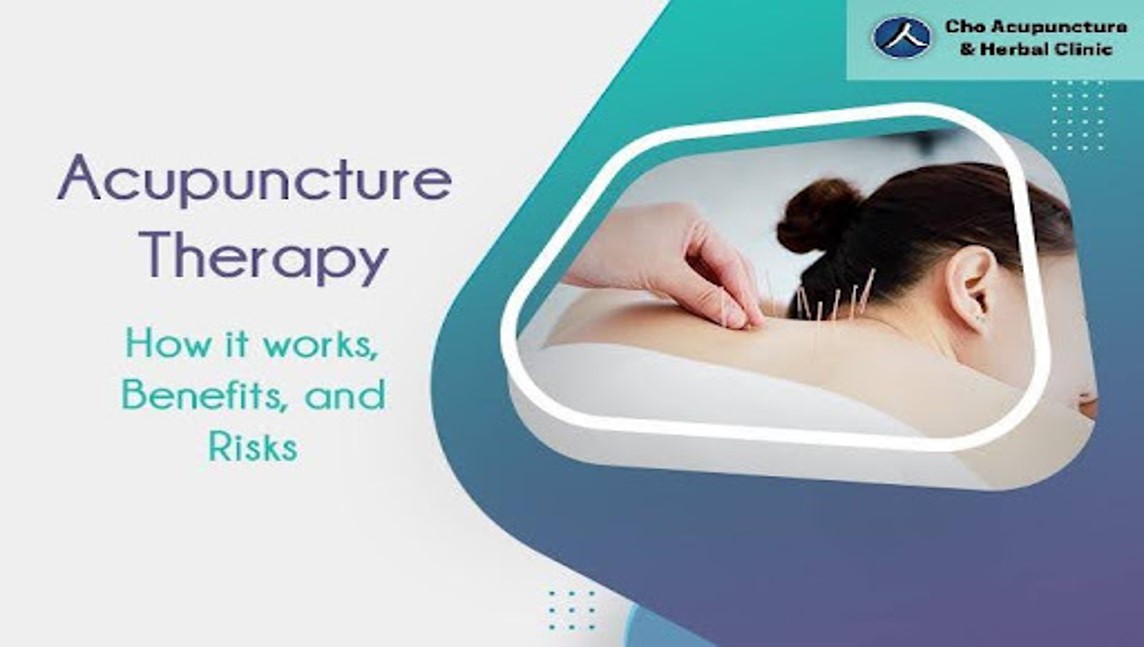Acupuncture Therapy: How It Works, Benefits, and Risks

Acupuncture for Pain Relief: What the Research Says
October 4, 2024Acupuncture therapy is gaining recognition as an effective complementary treatment. Rooted in Traditional Chinese Medicine (TCM), this ancient practice has found a place in modern healthcare systems. By using fine needles to stimulate specific points on the body, acupuncture aims to restore the natural flow of energy, or Qi. This comprehensive guide will delve into how acupuncture works, its benefits, and the potential risks associated with this holistic therapy.
To explore more about acupuncture and related treatments, visit the Cho Acupuncture & Herbal Clinic website.
Understanding Acupuncture: A Brief Overview
Acupuncture therapy has become increasingly popular as a complementary treatment, gaining attention from various healthcare sectors. It is based on Traditional Chinese Medicine (TCM) principles and aims to restore balance in the body by stimulating specific points. This ancient practice has been used for thousands of years to address a wide range of issues, including physical pain and emotional imbalances.
For a deeper look into the various services offered alongside acupuncture, check out the services page at Cho Acupuncture & Herbal Clinic.
Roots in Traditional Chinese Medicine (TCM)
Traditional Chinese Medicine views health as a harmonious balance of energy, or Qi (pronounced “chee”), flowing through pathways known as meridians. When this energy is blocked or imbalanced, illness and discomfort can occur. Acupuncture seeks to correct these imbalances by inserting fine needles into precise points along these meridians.
To learn how acupuncture and other TCM practices can benefit your health, visit Cho Acupuncture & Herbal Clinic.
Growing Acceptance in Western Healthcare Systems
In recent years, acupuncture has gained more acceptance within Western healthcare systems. Clinics and hospitals are incorporating it into holistic treatment plans, recognizing its potential benefits for pain management, stress relief, and overall well-being. Research has shown that acupuncture can activate the body’s natural healing processes, making it a valuable addition to conventional medical treatments.
Cho Acupuncture & Herbal Clinic, for instance, combines acupuncture with other TCM practices such as herbal remedies and cupping to provide comprehensive care tailored to individual needs. This integrative approach highlights the increasing acknowledgment of acupuncture’s role in promoting long-term health and wellness.
Understanding how acupuncture connects both ancient traditions and contemporary medical practices helps us appreciate its mechanisms and benefits.
How Acupuncture Works: A Scientific Perspective

Definition and Brief History of Acupuncture
Acupuncture, an integral component of Traditional Chinese Medicine (TCM), has been practiced for thousands of years. Originating in ancient China, this therapeutic technique is based on the concept of balancing the body’s energy, or Qi (pronounced “chee”). Historical records suggest that acupuncture has been used for over 2,500 years to treat various ailments and promote overall well-being.
The Core Idea: Balancing Energy Flow (Qi)
The fundamental principle behind acupuncture is the stimulation of specific points on the body to regulate the flow of Qi. According to TCM, Qi flows through pathways known as meridians. Disruptions or blockages in this energy flow can lead to illness and discomfort. By inserting fine needles into precise points along these meridians, acupuncture aims to restore balance and harmony within the body.
Acupuncture Points (Meridians) and Their Significance
Meridians are like invisible channels that transport Qi throughout the body. There are 12 primary meridians corresponding to major organs and functions, such as the heart, liver, lungs, and kidneys. Each meridian has specific acupuncture points that can influence its associated organ or function. For example:
- Lung Meridian: Involves points that help with respiratory issues.
- Stomach Meridian: Targets digestive problems.
- Kidney Meridian: Addresses issues related to reproductive health and vitality.
These points are carefully mapped out by acupuncturists who understand their significance in promoting health and treating diseases.
Needle Insertion and Its Influence on Energy Flow
During an acupuncture session, practitioners use thin, sterile needles inserted into selected acupuncture points. The insertion depth varies depending on the point’s location and the desired therapeutic effect. Once inserted, these needles can be gently manipulated by twirling or using a slight electric current to enhance their efficacy.
Physiologically, this process is believed to stimulate nerves, muscles, and connective tissues. This stimulation can:
- Trigger Endorphin Release: Helping to alleviate pain naturally.
- Improve Blood Circulation: Promoting healing and reducing inflammation.
- Modulate Nervous System Activity: Supporting relaxation and stress relief.
Acupuncture’s effectiveness lies in its ability to harmonize bodily functions by addressing both physical symptoms and underlying imbalances in Qi.
The Role of Acupuncture in Modern Medicine
Pain Management, Stress Relief, and Emotional Support
Acupuncture has become an important part of modern healthcare, especially for managing pain. Conditions like arthritis, lower back pain, and migraines often see significant improvement with acupuncture therapy. By targeting specific acupuncture points, the treatment helps to stimulate natural pain-relieving chemicals in the body, such as endorphins.
For specialized treatments like pain relief or stress management, explore the range of services provided at Cho Acupuncture & Herbal Clinic.
Another area where acupuncture is highly effective is stress relief. The pressures of life can lead to chronic stress, which negatively impacts both physical and mental health. Acupuncture sessions help to reduce stress levels by balancing the body’s energy flow (Qi) and promoting relaxation. This makes it an appealing complementary therapy for individuals struggling with anxiety and emotional imbalances.
Clinical Research Supporting Effectiveness
Scientific studies support the effectiveness of acupuncture for various conditions:
- Pain Relief: Research has shown that acupuncture can be as effective as traditional treatments for chronic pain. A comprehensive analysis published in the Journal of Pain found that patients receiving acupuncture reported greater pain relief compared to those receiving standard care.
- Mental Health: Studies indicate that acupuncture can alleviate symptoms of depression and anxiety. A research article in General Hospital Psychiatry reported that patients with major depressive disorder experienced significant mood improvements after consistent acupuncture treatments.
- Sleep Disorders: Individuals suffering from insomnia also benefit from acupuncture. A review published in Sleep Medicine Reviews concluded that acupuncture might improve sleep quality and duration by regulating neurotransmitters involved in sleep cycles.
Modern healthcare settings are increasingly incorporating acupuncture into comprehensive treatment plans. Hospitals and clinics often offer it alongside conventional therapies to enhance patient outcomes, making it a versatile tool in holistic health management.
Benefits of Acupuncture Therapy

1. Pain Relief for Chronic Conditions like Arthritis and Migraines
Acupuncture has gained recognition for its effectiveness in alleviating chronic pain conditions, particularly arthritis and migraines. This ancient practice is rooted in the principles of Traditional Chinese Medicine (TCM), where it focuses on restoring the body’s natural balance by targeting specific points with fine needles.
Arthritis: Chronic arthritis sufferers often experience significant relief through acupuncture. The needles stimulate nerves, muscles, and connective tissues, promoting blood flow and releasing endorphins—natural painkillers produced by the body. Studies have shown that regular acupuncture sessions can reduce joint inflammation and enhance mobility, providing a non-drug option for managing arthritis pain.
Migraines: For individuals grappling with migraines, acupuncture offers a promising alternative to conventional treatments. By targeting specific points associated with headache relief, this therapy can reduce the frequency and severity of migraine episodes. Research indicates that acupuncture may modulate pain pathways in the brain and influence neurotransmitter levels, leading to less intense migraine attacks.
Patients often report experiencing an overall improvement in their quality of life after incorporating acupuncture into their treatment regimen. This holistic approach not only addresses the symptoms but also aims to treat the underlying causes of pain, providing sustainable relief without the side effects commonly associated with long-term medication use.
“Acupuncture is a safe and effective treatment for chronic pain conditions such as arthritis and migraines,” says Una Cho from Cho Acupuncture & Herbal Clinic.
Incorporating acupuncture into your healthcare plan can pave the way for enhanced physical function and a better quality of life. With its growing acceptance in Western medicine, patients have access to this complementary therapy as part of a comprehensive approach to managing chronic pain conditions.
By focusing on these key areas, acupuncture demonstrates its versatility and efficacy across various chronic pain scenarios, making it a valuable addition to modern healthcare practices.
For personalized care tailored to chronic pain relief, visit Cho Acupuncture & Herbal Clinic.
2. Improved Physical Function and Reduced Reliance on Pain Medications
Acupuncture therapy offers a significant benefit by enhancing physical function and reducing the need for pain medications. For individuals suffering from chronic pain, such as arthritis or migraines, this therapy can provide a non-drug approach to managing discomfort.
1. Improved Physical Function
By targeting specific acupuncture points (meridians) in the body, acupuncture can help to alleviate muscle stiffness, increase mobility, and improve overall physical function. This can be particularly beneficial for patients with conditions like osteoarthritis, where joint flexibility and movement are often compromised.
2. Decreased Dependence on Pain Medications
Chronic pain sufferers frequently rely on medications that can have side effects and lead to dependency issues. Acupuncture provides an alternative by stimulating the body’s natural pain-relief mechanisms, potentially reducing the need for pharmaceutical interventions. This is supported by studies showing that regular acupuncture sessions can lead to a decreased reliance on medications like opioids or NSAIDs.
By incorporating acupuncture into their wellness routine, patients may experience enhanced physical capabilities and a safer approach to pain management.
3. Positive Impacts on Mental Health Conditions such as Anxiety and Depression
Acupuncture therapy has shown promising results in improving mental health conditions, particularly anxiety and depression. By stimulating specific acupuncture points, the treatment helps regulate neurotransmitters and hormones that play a critical role in mood regulation.
Anxiety Relief
Acupuncture can reduce symptoms of anxiety by promoting relaxation and reducing stress hormones like cortisol. Patients often report feeling calmer and more balanced after sessions.
Depression Management
The therapy assists in alleviating symptoms of depression by increasing the production of serotonin and endorphins, which are natural mood lifters. This holistic approach can be particularly beneficial when used alongside conventional treatments like medication and therapy.
Exploring the benefits of acupuncture therapy reveals a multidimensional approach to mental wellness, addressing both physical discomforts and emotional imbalances.
Potential Risks Associated with Acupuncture Treatment

1. Common Side Effects like Bleeding or Bruising at Needle Insertion Sites
Acupuncture is generally considered safe when performed by a trained and licensed practitioner. However, it is not entirely without risks. One of the most frequently reported side effects includes minor bleeding or bruising at the needle insertion sites. This occurs because the thin needles may puncture small blood vessels just beneath the skin’s surface.
- Bleeding: Typically, bleeding is minimal and stops almost immediately after the needle is removed. It’s a common occurrence that shouldn’t cause alarm.
- Bruising: Bruises can form when blood leaks into surrounding tissues. These are usually small and resolve on their own within a few days to a week.
Other common side effects include:
- Soreness: Some individuals might experience soreness at the needle insertion points. This discomfort is usually mild and temporary.
- Dizziness or Fainting: A small number of patients might feel dizzy or faint during or after an acupuncture session, often due to anxiety or sensitivity to needle insertion.
For safe and professional acupuncture services, book a consultation at Cho Acupuncture & Herbal Clinic.
2. Rare Complications such as Infection or Organ Puncture
Though rare, more serious complications can arise from acupuncture treatment if not performed correctly.
- Infection: There is a risk of infection if the needles used are not sterile. Licensed practitioners use single-use, disposable needles to mitigate this risk significantly.
- Organ Puncture: In very rare cases, improper needle technique could lead to organ puncture, particularly in areas near the lungs or other vital organs. This underscores the importance of seeking treatment from experienced and well-trained professionals.
Precautionary Measures
To minimize these risks:
- Ensure your acupuncturist is certified and uses sterile, single-use needles.
- Discuss any underlying health conditions with your practitioner before beginning treatment.
- Inform your acupuncturist if you are on blood-thinning medications as these can increase the likelihood of bruising or bleeding.
Understanding these potential risks helps set realistic expectations for acupuncture therapy while allowing you to make informed decisions about your health care options.
2. Rare Complications such as Infection or Organ Puncture
Although acupuncture is generally considered safe when performed by a qualified practitioner, there are rare but serious complications that could arise from improper needle technique. These risks associated with treatment include:
- Infection: Non-sterile needles can introduce bacteria into the body, leading to infections at the needle insertion sites.
- Organ Puncture: If needles are inserted too deeply or inaccurately, there’s a risk of puncturing vital organs such as the lungs or liver, causing severe medical emergencies.
It’s crucial to choose a licensed acupuncturist who adheres to strict hygiene and safety protocols to minimize these risks.
Professional Acupuncture Treatment: What to Expect?

Initial Consultation with a Qualified Acupuncturist
When seeking professional acupuncture treatment, the initial consultation is a crucial step. During this session, a qualified acupuncturist will take a comprehensive health history, assessing various aspects of your physical and emotional well-being. This may include:
- Discussing Medical History: The acupuncturist will ask about past medical conditions, surgeries, medications, and any ongoing treatments.
- Understanding Symptoms: Detailed questions about current symptoms and their impact on daily life help pinpoint specific issues.
- Lifestyle Factors: Diet, exercise routines, sleep patterns, and stress levels are also considered to create a holistic view of your health.
Importance of Personalized Treatment Plans
Acupuncture thrives on the principle that every individual is unique. Personalized care plans are meticulously crafted to address each patient’s specific needs. These plans may include:
- Tailored Acupuncture Points: Specific points chosen based on your condition ensure effective treatment.
- Complementary Therapies: Herbal treatments, cupping, guasha, or moxibustion may be recommended to enhance healing.
- Ongoing Assessment: Regular follow-ups allow for adjustments to the treatment plan based on progress and changing needs.
Promoting Overall Wellness Through Holistic Healing
Professional consultation with a skilled acupuncturist ensures personalized care plans that not only treat symptoms but also promote overall wellness. By addressing the root cause of health issues through holistic methods, patients can experience significant improvements in their quality of life.
“At Cho Acupuncture & Herbal Clinic, personalized care is central to our practice. Each treatment plan is designed to restore balance and support long-term health.” – Una Cho
This approach encourages individuals to embrace natural therapies tailored to their unique health profiles. Seeking professional acupuncture treatment can be an essential step towards achieving optimal health and well-being.
Exploring Other Holistic Practices Offered Alongside Acupuncture Therapy
Acupuncture Therapy: How It Works, Benefits, and Risks often extends beyond just needle insertion. A variety of alternative healing therapies can complement acupuncture to create a more holistic approach to health and well-being. Some of these practices include:
Herbal Treatments
- Herbal treatments are rooted in Traditional Chinese Medicine (TCM) and involve the use of natural plant-based remedies.
- These customized herbal prescriptions address specific health conditions such as hormonal imbalances, digestive issues, and immune disorders.
- They work synergistically with acupuncture to promote internal healing.
Cupping Therapy
- Cupping therapy uses suction cups placed on the skin to create negative pressure, drawing out toxins and improving blood flow.
- It is particularly effective for relieving muscle tension, enhancing circulation, and reducing inflammation.
- Often used by athletes, cupping therapy can accelerate recovery from physical exertion or injuries.
Guasha
- Guasha involves scraping the skin with a smooth-edged tool to stimulate microcirculation of soft tissue.
- This technique helps relieve chronic pain, reduce inflammation, and improve overall circulation.
- Guasha is often recommended for conditions like back pain or respiratory problems.
Moxibustion
- Moxibustion is a therapy that utilizes the heat generated from burning herbs (usually mugwort) near the skin’s surface.
- The warmth stimulates acupuncture points, enhancing the therapeutic effects of acupuncture.
- This method is beneficial for treating cold-related ailments and boosting overall energy levels.
Combining these holistic practices with acupuncture can amplify healing effects. Each therapy targets different aspects of well-being, creating a comprehensive treatment plan that addresses both physical and emotional health needs. Employing a blend of these techniques fosters a balanced approach to achieving optimal health.
Conclusion: Is Acupuncture Right for You?
Acupuncture therapy offers a wide range of potential benefits, including:
- Pain relief for conditions like arthritis and migraines
- Improved physical function and reduced reliance on pain medications
- Positive impacts on mental health, such as alleviating anxiety and depression
However, it is essential to be aware of potential risks:
- Common side effects like bleeding or bruising at needle insertion sites
- Rare complications, including infection or organ puncture
Before starting any treatment, especially if you have underlying health conditions, consulting with a healthcare provider is crucial. A professional evaluation ensures that acupuncture aligns with your overall health needs and goals.
For those considering acupuncture, seeking guidance from a qualified acupuncturist can provide personalized care plans that promote wellness through holistic healing methods. Whether it’s pain management, stress relief, or enhanced physical function, acupuncture might offer the support you need.
For more information on acupuncture therapy and other holistic practices, visit Cho Acupuncture & Herbal Clinic.





